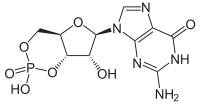
Cyclic guanosine monophosphate (cGMP) is a cyclic nucleotide derived from guanosine triphosphate (GTP). cGMP acts as a second messenger much like cyclic AMP, most notably by activating intracellular protein kinases in response to the binding of membrane-impermeable peptide hormones to the external cell surface
Synthesis
cGMP synthesis is catalyzed by guanylate cyclase (GC), which converts GTP to cGMP. Membrane-bound GC is activated by peptide hormones such as the atrial natriuretic factor, while soluble GC is typically activated by nitric oxide to stimulate cGMP synthesis.
Effects
cGMP is a common regulator of ion channel conductance, glycogenolysis, and cellular apoptosis. It also relaxes smooth muscle tissues. In blood vessels, relaxation of vascular smooth muscles lead to vasodilation and increased blood flow.
cGMP is a secondary messenger in phototransduction in the eye. In the photoreceptors of the mammalian eye, the presence of light activates phosphodiesterase, which degrades cGMP. The calcium ion channels in photoreceptors are cGMP-gated, so degradation of cGMP causes calcium channels to close, which leads to the hyperpolarization of the photoreceptor's plasma membrane and ultimately to visual information being sent to the brain.[citation needed] GMP and a number of its derivatives also have an umami taste
Degradation
Numerous cyclic nucleotide phosphodiesterases (PDE) can degrade cGMP by hydrolyzing cGMP into 5'-GMP. PDE 5, -6 and -9 are cGMP-specific while PDE1, -2, -3, -10 and -11 can hydrolyse both cAMP and cGMP.
Phosphodiesterase inhibitors prevent the degradation of cGMP, thereby enhancing and/or prolonging its effects.
Protein kinase activation
cGMP is involved in the regulation of some protein-dependent kinases. For example, PKG (protein kinase G) is a dimer consisting of one catalytic and one regulatory unit, with the regulatory units blocking the active sites of the catalytic units.
cGMP binds to sites on the regulatory units of PKG and activates the catalytic units, enabling them to phosphorylate their substrates. Unlike with the activation of some other protein kinases, notably PKA, the PKG is activated but the catalytic and regulatory units do not disassociate.
No comments:
Post a Comment